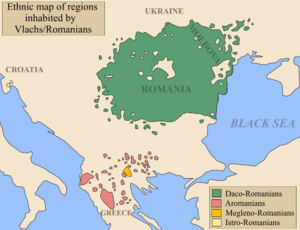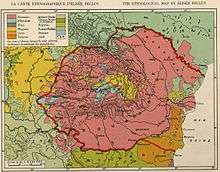Vlachs of Serbia
 | |
| Total population | |
|---|---|
| (35,330 (2011 census)[1]) | |
| Regions with significant populations | |
| Eastern Central Serbia | |
| Languages | |
| Vlach and Serbian | |
| Religion | |
| Predominantly † Orthodox Christianity | |
| Related ethnic groups | |
| Serbs, Romanians, Moldovans |
The Vlachs (Vlach: Rumînji / Румйњи, Serbian: Власи / Vlasi) are an ethnic group of Serbia. They mostly live in the Timočka Krajina region (roughly corresponding to the districts of Bor and Zaječar), but also in Braničevo and Pomoravlje districts. A small Vlach population also exists in Smederevo and Velika Plana (Podunavlje District), and in the municipalities of Aleksinac and Kruševac (Rasina District).
History
Northeastern Serbia was settled by the Vlachs from Banat, parts of Transylvania, and Oltenia (Lesser Walachia). These are the Ungurjani (Унгурјани), Munćani (Мунћани) and Bufani (Буфани). In the 19th century other groups of Vlachs originating in Wallachia (today Oltenia) also settled south of the Danube.[2] These are the Carani (Царани), who form some 25% of the modern population. Their very name Carani indicates their origin in Wallachia. From the 15th through the 18th centuries large numbers of Serbs also migrated across the Danube, but in the opposite direction, to both Banat and Wallachia. Significant migration ended with the establishment of the kingdoms of Serbia and Romania in the second half of the 19th century.
The lack of detailed census records and the linguistic influence of the Ungurjani and Carani on the entire Vlach population make it difficult to determine what fraction of the present Vlachs can trace their origins directly to the ancient south-of-the-Danube Vlachs. The Vlachs of northeastern Serbia form a contiguous linguistic, cultural and historic group with the Vlachs in the region of Vidin in Bulgaria as well as the Romanians of Banat and Oltenia (Lesser Wallachia).
Some authors consider that the majority of Vlachs in Timočka Krajina are descendants of Vlachs that migrated from Hungary in the 18th and 19th centuries.[3]
Culture
Language
The Vlach language consists of two distinct dialects.
Religion
Most Vlachs of Serbia are Orthodox Christians who had belonged to the Serbian Orthodox Church.
The relative isolation of the Vlachs has permitted the survival of various pre-Christian religious customs and beliefs that are frowned upon by the Orthodox Church. Vlach magic rituals are well known across modern Serbia. The Vlachs celebrate the praznjik, called in Serbian praznik or slava, though its meaning is chtonic (related to the house and farmland) rather than familial.
Subgroups
The Vlach community is divided into several groups, each speaking their own dialectal variant:
- the Carani of the Bor, Negotin and Zaječar regions are closer to Oltenia (Lesser Walachia) in their speech and music. The Carani have the saying "Nu dau un leu pe el" (He's not worth even a leu). The reference to "leu" (lion) as currency most likely goes back to the 17th century when the Dutch-issued daalder (leeuwendaalder) bearing the image of a lion was in circulation in the Danube principalities and elsewhere in the Ottoman Empire whose own currency was habitually being debased by the government. In the Romanian principalities, as well as in Bulgaria, the leeuwendaalder (in Romanian and Bulgarian leu and lev, respectively) came to symbolize a strong currency. Indeed, on gaining independence in the 19th century both countries adopted this name for their new currencies.
- the Ungurjani of Homolje are related to Banat and Transylvania, since Unguriani (compare with the word "Hungarians") is a term used to refer the Vlachs who once lived in provinces formerly part of the Kingdom of Hungary. The connection is evident not only in vocabulary, but also in the similarities of dialectal phonology and folk music motifs, as well as in sayings such as "Ducă-se pe Mureş" (May the Mureş take him/it away), a reference to the Transylvanian river. There is also a sub-group known as Ungurjani-Munćani , "the Ungurjani from the mountains".
- Bufani are immigrants from Lesser Walachia (Oltenia).
There has been considerable intermixing between the Ungurjani and Carani so that a dialect has evolved sharing peculiarities of both regions. There is also a population of Vlachophone (Vlach-speaking) Romani centered around the village of Lukovo, as well as a few Aromanian families who live in Knjaževac, but both are tiny migrant groups.
Population
.jpg)
In the 2011 census 35,330 people in Serbia declared themselves ethnic Vlachs, and 43,095 people declared themselves speakers of the Vlach language.[4] The Vlachs of Serbia are recognized as a minority. Therefore, the number of people of Vlach origin could be bigger than the number of recorded Vlachs, both due to mixed marriages with Serbs and also Serbian national feeling among some Vlachs.
The Vlach population of Central Serbia is concentrated mostly in the region bordered by the Morava River (west), Danube River (north) and Timok River (south-east). See also: List of settlements in Serbia inhabited by Vlachs.
Identity

The term Vlach is the English transcription of the term for this group (Vlahi). Romania has given modest financial support to the Vlachs in Serbia who declared as Romanians for the preservation of their culture. The Movement of Romanians-Vlachs in Serbia, which represents some Vlachs, has called for the recognition of the Vlachs as a Romanian national minority. However, the results of the last census showed that most Vlachs of Serbia declared as Vlachs not as Romanians. On the other hand, some Vlachs consider themselves to be Serbs that speak the Vlach language.
Vlach is commonly used as a historical umbrella term for all Latin peoples in Southeastern Europe (Romanians proper or Daco-Romanians, Aromanians, Megleno-Romanians, Istro-Romanians). After the foundation of the Romanian state in the 19th century, Romanians living in the Romanian Old Kingdom and in Austria-Hungary the use of the exonym "Romanians" was encouraged even by officials, and the Romanian population ceased to use the exonym "Vlach" for their own designation. Only in the Serbian and Bulgarian Kingdom, where the officials did not encourage the population to use the modern exonym "Romanian", was the old designation "Vlach" retained, but the term "Romanian" was used in statistical reports (but only up to the Interwar period).[5] For this reason, the romance-speaking population of Vojvodina (hence those who lived in Austria-Hungary) today prefer to use the modern exonym "Romanian", while those of Central Serbia still use the ancient exonym "Vlach".
In some notes of the government of Serbia, officials recognise that "certainly members of this population have similar characteristics with Romanians, and the language and folklore ride to their Romanian origin". The representatives of the Vlach minority sustain their Romanian origin.
Legal status

Since 2010, the Vlach National Council of Serbia stated that no one has the right to ask the Vlach minority in Serbia to identify themselves as Romanian or veto anything, firstly because there already is a recognized Romanian minority within Serbia, and because Vlach people in Serbia do not feel discriminated or underprivileged. He also said that Vlachs regard Serbia as their homeland.
On 1 March 2012, Romania and Serbia signed an agreement concerning the Vlach population in Serbia.[6] According to the agreement, members of the Vlach community can declare themselves to be Romanians, and those who do so can have access to education, media and religion in their language.[7]
Notable Vlachs
- Branko Olar, one of the best known singers of folklore from Eastern Serbia, originating from the village of Slatina near Bor
- Staniša Paunović, a well-known folklore singer, originating from Negotin, from Eastern Serbia
See also
References
- ↑ http://media.popis2011.stat.rs/2011/prvi_rezultati.pdf Serbian Preliminary 2011 Census Results
- ↑ (Serbian) Kosta Jovanović, Negotinska Krajina i Ključ, Belgrade, 1940
- ↑ Aspects of the Balkans: continuity and change. Contributions to the International Balkan Conference held at UCLA, October 23–28, 1969
- ↑ (Serbian) "Official Results of Serbian Census 2011–Population by ethnic groups" (PDF). (477 KB), p. 2 and "Official Results of Serbian Census 2011–Population by language" (PDF). (441 KB), p. 12
- ↑ Serbian/Romanian. The Helsinki Committee for Human Rights in Serbia. The Vlachs/Romanians or the Romanians of Eastern Serbia and the "Vlach/Romanian question". Bor 2000/2001/2002.
- ↑ B92 - Vesti - Sve je rešeno, Srbiji kandidatura
- ↑ B92 - Vesti - Basesku: "Rumunski problem" naduvan
Sources
- T. R. Georgevitch (1919). The truth concerning the Rumanes in Serbia. Paris: Graphique.
- Mihai Viorel Fifor (2000), "Assimilation or Acculturation: Creating Identities in the New Europe. The Case of Vlachs in Serbia", Cultural Identity and Ethnicity in Central Europe, Cracow: Jagellonian University
External links
- The National Council of the Vlach national minortiy
- Community of Vlachs of Serbia
- Maps of Vlachs in north-east Serbia
